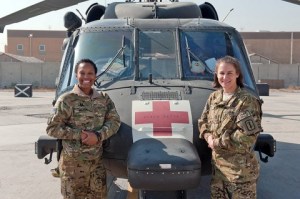I like to believe that every day nurses do something heroic for people, even if that something is trifling. We make small sacrifices every day for our patients, like forgoing a meal, or a trip to the bathroom, staying late to make sure our patient’s care is complete, and spending holidays caring for our sick patients instead of sitting down to dinner with our families. But when I think about the sacrifice our military nurses make, I quickly realize a grumbling stomach, and a full bladder are inconsequential in comparison.
Today is Veterans Day, a day I hold in high esteem. I honor all the men and women who serve this great nation. However, when I think of what it truly means to sacrifice, I am drawn to the battlefield nurses who are not only hungry, and running with full bladders, but are putting their lives in danger to care for the heroes that defend our nation. Battlefield nursing launched our most famous leader, Florence Nightingale, into the history books, during her time in the Crimean War. Her dedication to service, her intellect, and her ability to improve battlefield conditions, while reducing soldier mortality rates in the wounded, changed the face of nursing care not only on the front lines, but in each and every hospital as well.
In America George Washington understood the importance of the battlefield nurse, and in 1775 The Congressional Resolution allotted one nurse for every 10 patients in military hospitals, and provided nurses a salary, though meager, at two dollars per month. Up until that time, nurses positions had traditionally been voluntary. By 1777 George Washington put out a call for more nurses, and the salary was increased to eight dollars per month. Nurse’s time on the battlefield did not end with George Washington. From 1861-1865 over 3000 nurses served in the Union Army during the Civil War. By this time nurses were earning 12 dollars per month and rations, however, nurses were always at risk of contracting contagious diseases, and battlefield injuries.
In 1917 when WWI raged across Europe, over 12,000 American nurses were ready to serve. They were deployed all over the world. Again in 1941, after the bombing of Pearl Harbor, nurses came forward to serve in the Second World War. For the past nearly seven decades Nurses have served in Korea, Vietnam, Iraq, and Afghanistan. To date, approximately 1000 nurses have lost their lives in the line of duty. A true sacrifice!
I recently came across this article about one of those brave nurses who made the ultimate sacrifice doing her job, caring for the soldiers, and country, she swore to protect. She is the kind of woman, nurse, and human being I would hope all of us aspire to be. Today’s Veterans Day post is dedicated in her honor: Jennifer M. Moreno.

An undated photo provided by the U.S. Army shows Army 1st Lt. Jennifer M. Moreno. Moreno, 25, of San Diego, Calif., an Army nurse from Madigan Army Medical Center at Joint Base Lewis-McChord, was one of four people killed Sunday, Oct. 5, 2013 by an improvised explosive device in Afghanistan. (AP Photo/US Army)
Everyday we have choices to make. Some may be small, some large; others may be easy, while some may be life changing. On October 6, 2013 Captain Jennifer Moreno, an Army Special Operations Command Nurse was on assignment with her comrades in Afghanistan attempting to capture a high value target. Instead of the high value target surrendering, an Afghan woman came out and detonated her suicide vest, wounding six troops. That explosion then set of an IED. As soldiers rushed to help the injured troops, they set off another IED. A second Afghan emerged from the building, detonated his suicide vest, killing Jani a working military dog.
Ground soldiers were ordered to stay in place by their commander, but Moreno heard the cry of help for a wounded soldier. It is in that moment where Moreno’s choice represented duty to serve, and Captain Moreno chose not to stay in place, but to perform her commitment, and follow the Nurses Code of Ethics, as well as the soldiers creed to “never leave a fallen comrade”, to go help save her fellow soldiers. It was a choice that would prove to be fatal.
In over a century of war, we have lost many nurses to the side effects of conflict whether by disease, or injury. I would like to take the time to honor those listed below, and thank them for their service, and their ultimate sacrifice.
Spanish American War: 21 Nurses died of typhoid and malaria.
WW I: 430 Nurses died from the 1918 Influenza outbreak.
WW II: 460 nurses died. Six Army Nurses died in hostile fire at Anzio Beachhead in 1944. Six Army Nurses died when a Japanese suicide plane crashed into the Hospital Ship USS Comfort near the Philippine Islands in 1945.
Korea: 16 Army, Navy, and Airforce Nurses died enroute to the battlefield
Vietnam War: 8 Nurses died in enroute to the battlefield. Army Nurse Lt. Sharon Lane died from hostile fire.
Iraq: Army Nurse Capt. Maria Inez Ortiz was killed by a mortar attack in the Green Zone in Baghdad. Army Nurse Captain Gussie Jones died in Iraq of non-battle related causes.
Ft. Hood Texas: Army Psychiatric Nurse Captain John Gaffney, Army Mental Health Adult Nurse Practitioner Captain Russell Seager, and Army Psychiatric Nurse Practitioner Lt. Colonel Juanita Warman were all killed by hostile fire when Major Nidal Malik Hasan opened fire on them.
Afghanistan: Army Nurse Captain Jennifer Moreno killed in and IED explosion. Army Nurse Practitioner, Lt. Colonel Richard Berrettini died from injuries after his vehicle was hit by an IED. Army Nurse Captain Bruce Clark collapsed, and died during deployment in Afghanistan. Army Certified Nurse Anesthetist Joshua McClimans was killed by indirect rocket or mortar fire from insurgents on his way to work at the Army Hospital in Afghanistan.
God bless all the men and women who have sacrificed their lives for our freedoms!









